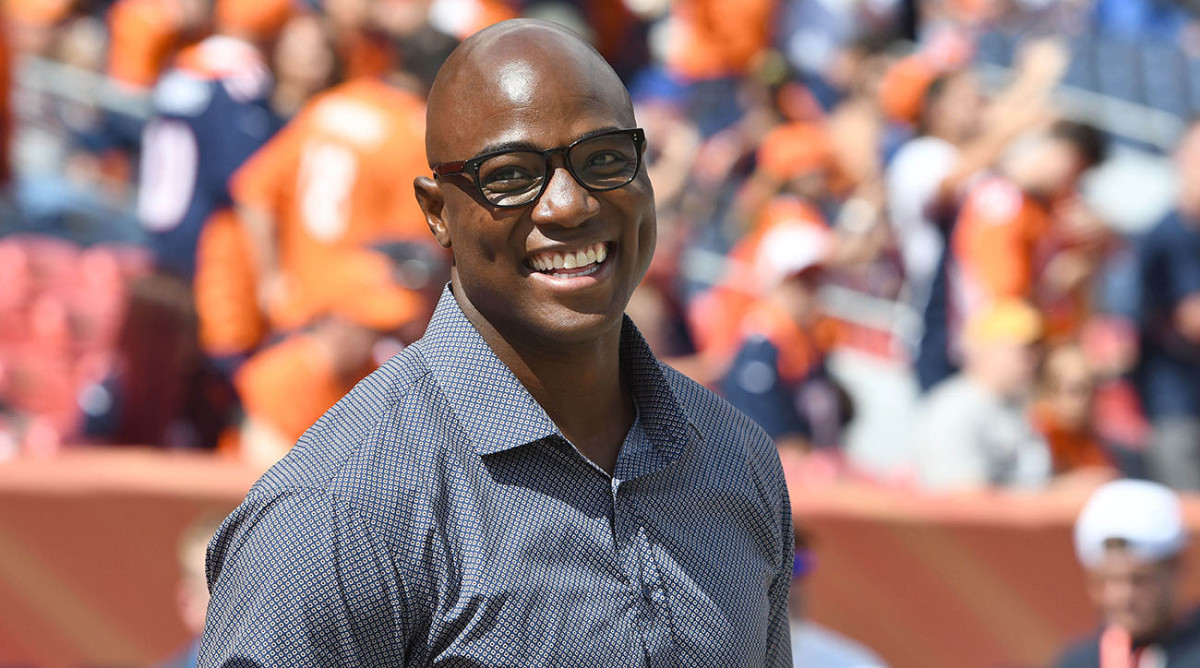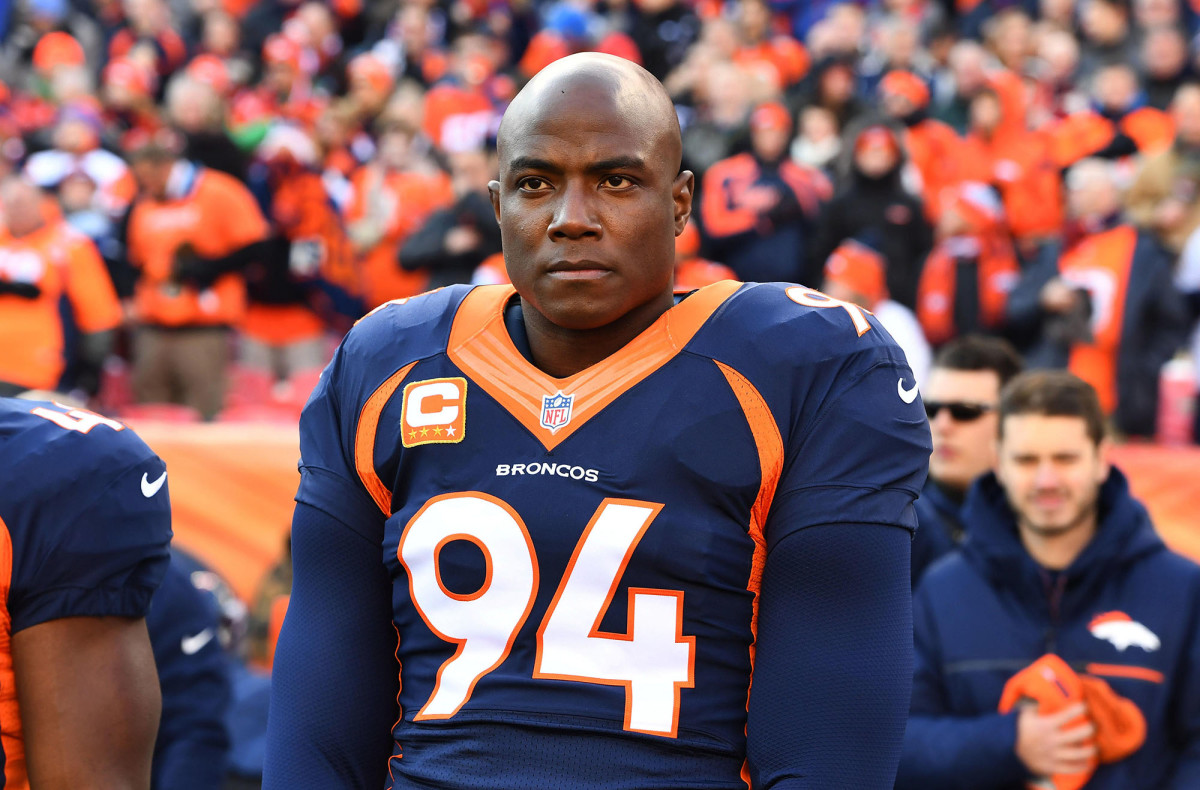Former NFL Star DeMarcus Ware Joins Passions for Fitness and Technology with New Venture
On a recent evening, DeMarcus Ware, the retired linebacker, reported to the retail space that fronts 3 Volt Fitness, his new training center in Trophy Club, Texas, and opened a box of shirts. They were wrinkled, so he picked up a steamer to press them, but noticed that a few members were looking at him, eyes locked in.
“Like I’m a mannequin,” he says. “I was like, How are you? What’s going on? You want me to show you around?”
Forgive the gawkers. At 6’4”, Ware, 38, still cuts a statuesque figure. Though he left the NFL in 2016 after 12 seasons—undergoing three back surgeries and one neck operation during that last campaign—he has not slowed. Each day, he still takes in between 5,000 and 6,000 calories and works out for an hour, referring to his body as a “fat-burning machine.” He’s always moving, hopping from one task to the next, be it on a treadmill or in the virtual world where he now operates.

In the midst of what he calls “a transition to another realm,” Ware has been busy despite the pandemic’s challenges. In July, he opened the gym, which boasts a class called “Get After That Ass.” And just last week he launched an app, Driven to Win, that allows users to feel like they are working out alongside Ware, who appears on screen as a lifelike 3D-model avatar. Following a dominant career on the field, Ware, who will enter the Alabama Sports Hall of Fame next May, believed the gym and app were the perfect way to intertwine two of his lifelong passions.
“I wanted to be at that intersection of training and technology,” he says. “I can bring it right to you now, sharing what got me going all those years. This is what I know.”
Ware learned to work out and lift weights in a gym with rusty barbells at the Boys & Girls Club in Auburn, Ala. In high school, he weighed in at 185 pounds as a wideout, but at Troy University, he developed into a defensive presence as he teamed with future NFL star Osi Umenyiora to record 25 sacks and 40 tackles for a loss in one season. Ware followed that up by wreaking havoc in the Sun Belt Conference with 32 quarterback hurries, five forced fumbles and two fumble recoveries the next year. The destruction drew the attention of scouts, and Dallas selected him with the No. 11 pick in the 2005 NFL Draft. Thereon, Ware absorbed lessons from veterans like Greg Ellis, Terrell Owens and Larry Newman on maintaining their explosiveness over time. Each placed a premium on recovery methods, and Ware took those early details to heart, monitoring what he put in his body and sharpening his approach.
But there was always a technological side to Ware. In his youth, he would sift through the floppy-disk hard drives that students at Auburn University would leave behind at the end of each semester. Then, he studied computer science as his major in college, and in the NFL, he grew more curious as teams implemented artificial intelligence and virtual reality components into game preparations and training techniques during the last decade. By the time he knew his career was winding down—when he could barely walk after games in his final year—he decided to focus his attention on melding his passions, as a way to find a natural role for himself outside the game.
“I always wanted to know more about what I could do better, differently,” he says.
Ware sought partners to make sure he could produce the right app. In 2018, he paired with Calvin Carter, the CEO of Bottle Rocket, a developer that has created apps for companies like Disney and Capital One. When it came to physical production, Ware and his colleagues constructed a room and positioned 300 cameras throughout the space. Constantly active, Ware and his fitness partner, Angela Daniel, performed and recorded more than 700 exercises for users to follow. To reinforce each step, Ware provided details as if he was instructor in the room with the user, offering tips on what angles to use and how to create leverage during sessions.

Ware knew the body and the toll exacted by career in professional football. As a reminder of his painful path, he kept the documentation of the 51 injuries he endured. But to establish himself in the fitness industry, he studied and gained his certification as a personal trainer. He is also studying muscle activation therapy and is in the process of becoming a certified nutrition coach. Instead of simply slapping his name on the business, he has taken to being involved with granular decisions. For now, he participates in classes with the clientele, but he aspires to someday lead sessions that span 45 minutes. He has also brought in top equipment, including a pilates machine, the M3X+ Megaformer with a ramp (which he boasts is the only one in Texas), as well as the FTG Woodway treadmills, which are non-motorized and provide a curved running surface.
"He is not just putting the money up," says Randi Chapman, a co-owner in the gym venture. “He’s exploring it all.”
Money is returning, as well. The app costs $14.99 a month or $99.99 for a full year. While the exercise list is expansive, he also plans on adding to the workout selection as time goes on. He recognized that there was risk in both opening the gym and unveiling the app amid the pandemic, but he also saw opportunity with people working from home and wanting to change up their routine since they were locked down or unable to exercise in their usual facilities. He follows cleanliness protocols—spaces are limited to meet local limits, each piece of equipment gets wiped down after use, masks are required upon entrance and temperatures are taken as a precautionary measure—while the coronavirus continues to complicate indoor gatherings. The air filtration system is also as important as ever.
“I accepted the challenge and took a chance,” he says. “A lot of people were like, Why start in a pandemic? I thought about what I have done in my life to get to college and the NFL and Super Bowl, and then I applied those lessons in starting the gym business.”
When Ware first retired, he did some work in television, but then he started thinking about what he really wanted to do with the fitness knowledge that he gained in playing for the Cowboys for nine seasons and winning a Super Bowl during his three-season tenure with the Broncos. He set up his first workout space in a two-car garage in his Texas brownstone, and went to work on imagining what he could relate to interested parties. After visiting with Apple’s app developers, he gauged what he could do with augmented reality and 3D visualization before he went about breaking down his process. After an initial testing phase, a personalized program is developed for each user and progress is tracked. For areas of the body that need attention, the technology recommends muscles to target.
Still, Ware wanted to know whether he could outsmart the technology that is programmed to prescribe your proper routine. After testing some of the programs on a local high school team, he tried to trick the app.
“I couldn’t do it,” he says. “It knew.”
Ware welcomed teammates to make cameo appearances on the app, as well. Broncos linebacker Von Miller is an avatar, as is Leighton Vander Esch. They are partnering with the NFLPA, and plans include the introduce of more athletes from across the athletic realm—MLS, WNBA, et al.—in order to expose users to the position-specific of workouts that elite athletes execute across the sporting spectrum.
Four months into his gym ownership, Ware has more than 100 members. He interacts with the clientele regularly, hops into classes and converses with newcomers. He keeps customers guessing by not appearing on schedules for classes. Still, he pops in unannounced to get his workouts in and tends to the details, as well. Disorder continues to annoy him, and he addresses issues as needed.
“If you need me to rearrange the barbells, I’m there for that, too,” he says.
